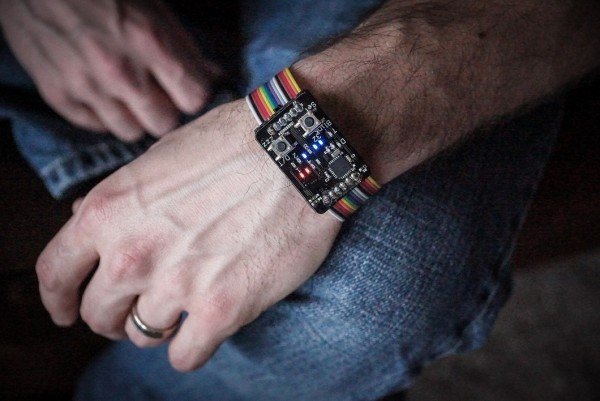Binary Watch
The Binary Wristwatch
Update: Due to the high demand for these, I’ve set up a batch to be professionally assembled, which should be shipping to customers April 20th. Preorders available on my webstore.
I used to get the feeling that it wasn’t obvious enough that I really enjoy working with embedded systems. I decided to change that by designing a binary timepiece that is portable, easy to use, has long battery life, and has a very barebones “circuits and components” feel to it. After wearing the final product for about a month now, I feel like I was successful on all of those goals:
I’m pretty proud of this project; the clasp is a ribbon cable that doubles as the programming interface for the PIC microcontroller that drives everything. The time is displayed with superbright LEDs that are blinding at 15 mA, which means that I’m able to limit the power consumption considerably while still achieving a very readable display. The watch is powered by the (ever so common and useful) CR2032 lithium coin cell, which gives it an estimated battery life of 3 months depending on usage patterns (still doing research and testing on the average for this… 2 months in and I’m still running on my first battery : )
I like this watch so much that I decided to make some for a few friends of mine. From there, I figured that since I had gotten to a point where I could make them without too much difficulty, I might as well sell them to see if I could recoup how much I’ve spent on component testing and PCB fabrication The completed watch is available at my storenvy page… or rather, it was, until I got a surge in demand for them an sold out. I’m getting a batch professionally assembled though. If you still want one, you can preorder here.
Hardware
The primary purpose of this project was to get some experience working with PIC MCUs for low power applications. I played with a 16F back in college in a microcontrollers class, but I have yet to use one since. I ended up using a PIC18F24J11 for this one. It contains an RTCC peripheral that can be calibrated and driven by an external crystal, enough GPIOs to drive the number of LEDs I want without having to introduce an external shifter, and a pretty attractive deep sleep mode that has just the right number of wake sources. Microchip makes a 28 QFN version of the chip, which is nice both for its small footprint and for the fact that I’ve been wanting to challenge myself a bit more lately with surface mount soldering.
For output, I have three sets of LEDs on the board: two for telling whether the time or date is being displayed and ten for actually conveying the numeric data. For ease of use, I added numbers to the silk screen in each LED column to denote which conveys 1, 2, 4, 8, and 32. I used superbright LEDs, which allows me to use pretty big current limiting resistors (16k). This keeps the power consumption of each LED very very low (<0.2 mA), which is vital for squeezing as much use as possible out of the 225 mAh you get with a CR2032.
For more detail: The Binary Wristwatch

